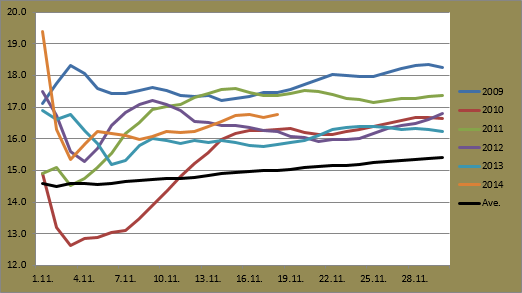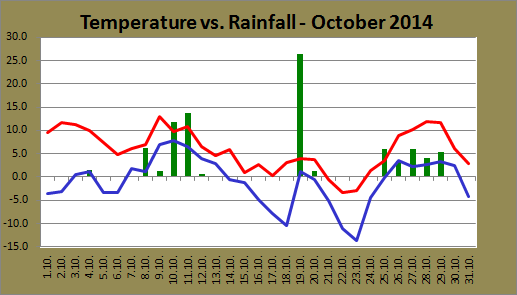It has been a very warm start to December this year. Today, the ninth day of the month, was the first that failed to top 28C at Sydney Airport. Of the other eight, only December 6 didn't go above 29C and now the average maximum after nine days sits at 29.8C. The previous respective figure above that was in 2005 when the first nine days of December had an average maximum of 30.3C.
Today's maximum of 24.6C ended not only a run of 10 straight days above 25C, the longest since a 12 day run from January 10 to 21 earlier this year, but also a 10 day run above 27C. The previous higher number of consecutive days above 27C was 12, from January 28 to February 8 back in 2009.
The month so far has been characterised by these very warm temperatures, but also by the build up of storms west of Sydney and their subsequent movement towards the coast in the late afternoon or evening. The week-long period between December 2 and 8 has seen strong wind gusts, hail, very heavy, localised rain and flash flooding across the city. Some figures and more information from the past week are below.
December 2
The month's second day saw falls in the early hours of the morning. A total of 6.2mm was recorded at the Airport, the highest daily total since October 15. It reached 31.2C in the afternoon, making it the first day above 30C in just over a week.
December 3
December 3 saw storm activity build during the early afternoon. Maximums around the city for what is the warmest day of the month so far included 33.1C at Sydney Airport, 36.5C at Badgerys Creek, while Richmond saw the highest temperature of the Sydney region with 37.7C.
Storms arrived just before 5pm in the west. Richmond saw an 80km/h wind gust at 5:02pm. A gust of 72km/h was also seen at the Airport 25 minutes later at 5:27pm. There were heavy falls in the west. Horsley Park, about 35km west of the city, saw the highest total in the region with 46.4mm. Sydney Olympic Park recorded 36.6mm while Observatory Hill saw 23.6mm. Only 9.2mm fell at the Airport.
December 4
Temperatures fell just short of 30C on Thursday December 4. Storms built more slowly and from a later point in the day compared to Wednesday. Their arrival to the Sydney region wasn't until later in the evening. From 10:30pm to 12:30am December 5, Sydney Airport recorded 21.4mm.
December 5
Friday afternoon saw a very menacing looking storm hit the city. The Airport was spared heavier falls though as only 0.8mm was recorded there during the whole day.
 |
December 5's storm approaching the city as viewed from Bondi Junction
Source: Reddit user h3ndofry - Imgur
|
 |
The view of the storm from Circular Quay as it charged east over Sydney Harbour
Source: Reddit user kalvin74 - Imgur
|
 |
The leading edge of the storm in Mona Vale on Sydney's Northern Beaches
Source: Reddit user It_Is_Known - Imgur |
December 6
The weekend continued in the same fashion as the previous few days. It reached
only 28.5C at the Airport, breaking a run of six days above 29C. Once again storms built in the mountains, this time to the north west of Sydney and headed in a southeasterly direction. Many locations around Sydney recorded their highest daily totals of the month so far. Sydney Olympic Park saw 39.4mm between 9am and midnight. Richmond recorded 33.6mm and the Airport 16.4mm.
A total of 49.6mm fell at Penrith. The Bureau of Meteorology's 49.6mm recording to 9am on December 7 was the highest 24 hours to 9am total there since January 29 last year.
December 7
Sunday was rather similar to Saturday with a storm in the late afternoon. Homebush again bore the brunt of the heavy ran with 44.2mm; 41.6mm of which fell between 4:30pm and 5:30pm. The Airport received 23.8mm in the hour between 5pm and 6pm. 24.2mm had fallen by midnight, the highest daily total of the month so far.
Earlier in the day, just after 12:30pm, Camden saw wind gusts up to 89km/h. The previous strongest gust was recorded almost exactly a year ago; December 5 2013 saw a gust of 106km/h.
December 8
Monday December 8 finally saw some respite for the city. A few showers were around in the morning and the Airport recorded 1.6mm between 6:30am and 8:30am. Temperatures climbed to 32.7C just before 1pm. A brief storm added a further 1.2mm to the daily total and a 76km/h wind gust was also recorded.
The seven day period above is the longest rain period since the beginning of September. With the monthly total at the Airport now standing at 81.2mm, it is also the wettest start to a December since 1992. Over 100mm was recorded in the first eight days then.
Other totals around the city so far this month include 162.0mm at Sydney Olympic Park, 137.8mm at Richmond, 111.6mm at Penrith and 103.2mm at Camden. Observatory Hill has escaped some of the heavier falls and its total currently sits at 65.8mm.
The coming week should see further falls around Sydney with showers increasing tomorrow to rain by Thursday. Temperatures will be a little cooler, but should still be comfortably above 20C.








































